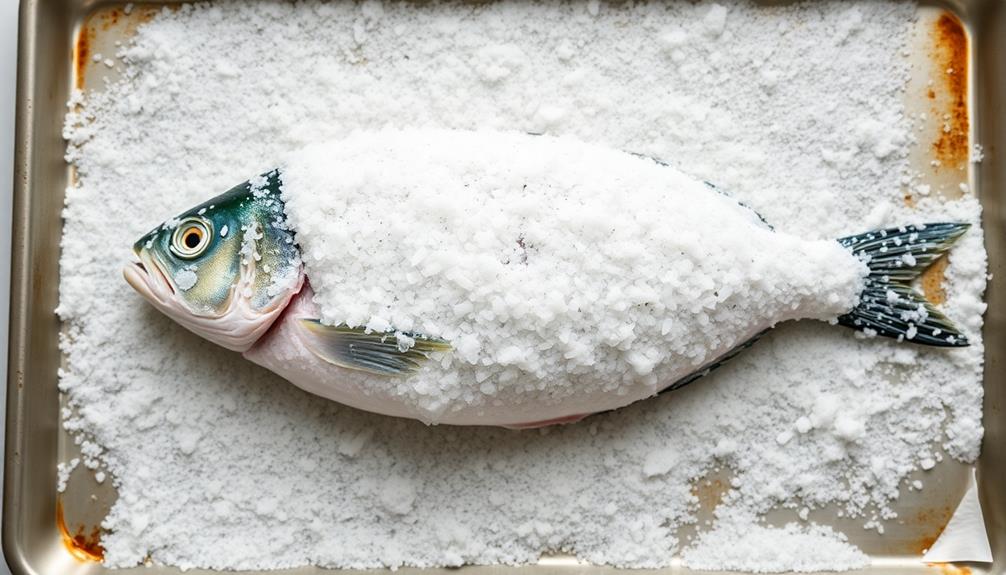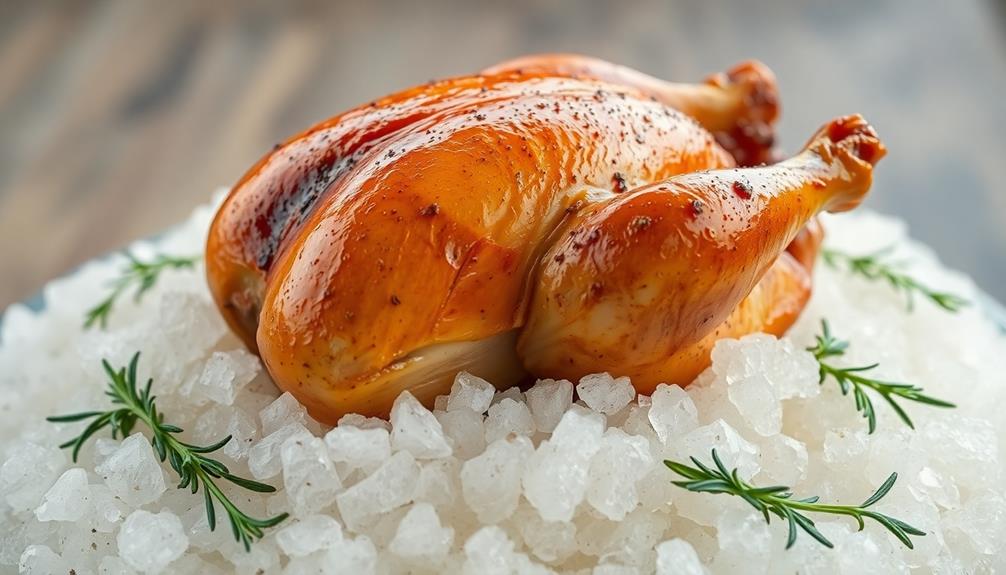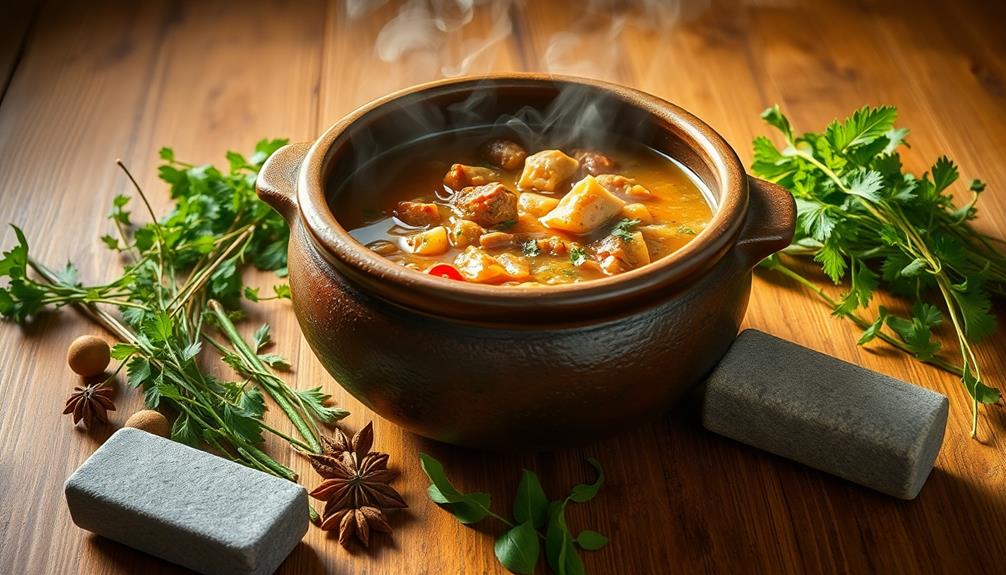Salt-crusted fish is an amazing way to lock in the natural moisture and flavors of fresh seafood! This centuries-old technique creates a visually stunning and delicious dish that'll impress your family and friends. It's surprisingly easy – just coat the fish in a thick layer of coarse salt, then bake until the salt forms a crunchy crust. When you crack it open, the fish inside will be wonderfully tender and juicy. You can use this method with all kinds of fish, from whole fillets to individual portions. Give it a try, and you'll discover why salt-crusting has stood the test of time! There's more to learn about this incredible cooking technique…
Key Takeaways
- The salt-crusting technique enhances moisture retention in fish by creating a flavorful crust that protects the fish during cooking.
- Salt-crusted fish is ideal for various types of fish, including whole fish and fillets, and can elevate a home-cooked meal to a restaurant-quality experience.
- The recipe requires high-quality, coarse sea salt as the primary component, and optional herbs and spices can be added for additional flavor.
- Cooking time varies based on the type of fish, with whole fish requiring 25-30 minutes and fillets requiring 15-20 minutes in a preheated oven at 450°F.
- The final product is a visually impressive and delicious main course, often served with lemon wedges and accompanied by seasonal vegetables or a fresh salad.
History
Salt-crusted fish has a rich history that can be traced back to ancient civilizations. Long ago, people living near the coasts discovered that covering their fish in a thick layer of salt before cooking helped lock in the natural moisture and flavor.
This simple technique became popular across the Mediterranean, where the warm climate and salty sea air made it an ideal method for preserving and preparing fish.
Over the centuries, the art of salt-crusted cooking evolved, with different cultures adding their own unique spices and seasonings. In Greece, you might find fish coated in a mixture of salt, lemon, and oregano.
Meanwhile, in Spain, the salt crust is often paired with garlic and paprika. No matter the specific recipe, the result is always the same – a perfectly moist and flavorful fish that's a delight to eat.
Recipe
Salt-Crusted Fish
Cooking salt-crusted fish is a classic and elegant way to prepare fresh, delicate fish. The salt crust seals in the moisture and flavor, creating a tender, flavorful fillet. This method works best with firm, white-fleshed fish like sea bass, halibut, or cod.
To make this dish even more enjoyable for young eaters, consider pairing it with eco-friendly and safe materials for toys that can enhance their dining experience through imaginative play. The key to a successful salt-crusted fish dish is to use a high-quality, coarse sea salt. The salt should completely encase the fish, forming a hard, crunchy crust that's easily removed before serving.
- 2 lb whole fish or fish fillets
- 3 cups coarse sea salt
- 2 egg whites
- 1 tbsp water
- Fresh herbs (such as thyme, rosemary, or parsley) for serving (optional)
Preheat the oven to 400°F. In a large bowl, mix the salt, egg whites, and water until a thick paste forms. Place the fish on a baking sheet and completely cover it with the salt mixture, pressing to adhere. Bake the fish in the preheated oven for 25-30 minutes, or until the salt crust is golden brown and the fish is cooked through. While the fish is baking, you can prepare the traditional Chinese steamed egg recipe by whisking together eggs, water, and seasoning before steaming until set. Serve the salt-crusted fish alongside the steamed egg for a delicious and balanced meal. Enjoy!
Bake for 25-30 minutes for whole fish or 15-20 minutes for fillets, until the salt crust is hard and the fish is opaque and flakes easily.
To serve, simply crack open the salt crust and gently lift the fish out. The salt crust can be easily removed, leaving behind a perfectly cooked, moist, and flavorful fillet. Garnish with fresh herbs, if desired. This salt-crusted fish makes an impressive and delicious main course.
Cooking Steps
Preheat your oven to a toasty 450°F.
Next, gently cover the fish in a thick layer of salt.
Now, bake the fish in the salt-crusted oven until it's perfectly cooked.
Carefully remove the salt crust and serve the delicious fish with fresh lemon wedges on the side.
Step 1. Preheat Oven to 450°F

Preheating the oven to 450°F is a crucial step in ensuring your salt-crusted fish turns out perfectly cooked.
You'll want to crank that oven up nice and hot, so it's ready to work its magic on your delicious seafood.
Once the temperature hits that magic number, you'll know it's time to slide your fish right in. The high heat is going to create a crisp, flavorful crust on the outside, while locking in all that juicy moisture on the inside.
Can you already smell that savory aroma wafting through your kitchen?
Don't be tempted to open the oven door too often – that hot air needs to stay put to work its culinary wonders.
Just sit back and let the oven work its magic for about 20-25 minutes. Your patience will be rewarded with a perfectly cooked, salt-crusted fish that's bursting with flavor in every bite.
Mmm, can't you just taste it already?
Step 2. Cover Fish in Salt

With your oven preheated to the perfect temperature, it's time to prepare the salt crust.
Grab a generous amount of coarse salt and sprinkle it evenly over a baking sheet or ovenproof dish. You want enough salt to completely cover the surface, creating a bed for your fish to rest on.
Next, place your fish fillets or whole fish directly on top of the salt. Gently press down to help the salt adhere. Don't worry if you have a few gaps – the salt will melt and form a nice, even coating as the fish cooks.
Now, use your hands to pack more salt around the sides of the fish, sealing in the moisture. This salty shell will create a deliciously crisp exterior while keeping the inside wonderfully tender and juicy.
Get ready for a flavor explosion when you crack open this salt-crusted masterpiece!
Step 3. Bake Fish in Salt-Crusted Oven

Once the fish is nestled in the salt bed, slide the baking sheet into your preheated oven.
Listen for the sizzle as the salt begins to bake, infusing the fish with its bold, seasoning power. You'll know it's working when the salt transforms into a crunchy, protective crust around the edges.
As the fish roasts, that savory, salty aroma will start to fill your kitchen, making your mouth water in anticipation.
When the timer goes off, carefully remove the baking sheet from the oven.
The salt crust should have formed a seal, locking in all the natural juices and flavors of the fish.
Using a fork or spoon, gently crack open the crust, unveiling your perfectly cooked seafood treasure.
The meat will be moist, tender, and bursting with the pure essence of the sea.
Serve your salt-crusted fish hot, alongside your favorite sides, and get ready to wow your family and friends with this simple yet impressive technique.
Step 4. Remove Salt Crust

When the timer signals the fish is ready, carefully remove the baking sheet from the oven.
Grab your oven mitts, as the salt crust will be incredibly hot! Slowly and gently, lift the baked fish onto a serving platter. The salt crust should have a beautiful, golden-brown color.
Grab a fork and start chipping away at the crust. It will crack and crumble easily, revealing the moist, perfectly cooked fish inside.
Peel off the crust in large pieces, exposing the tender, flaky fillets. Discard the salt crust – you won't be eating that!
Take a moment to admire your work. The fish should now be glistening, ready to serve.
Grab a sharp knife and carefully slice into the fillets. They'll be so juicy and flavorful, thanks to the salt-crusting technique.
Serve the fish immediately, and enjoy the delicious results of your culinary skills!
Step 5. Serve Fish With Lemon Wedges

Serve the salt-crusted fish with a few fresh lemon wedges on the side. The bright, tangy flavor of the lemon is the perfect complement to the savory, crispy crust.
Squeeze a little lemon juice over the top of the piping hot fish, and watch as it sizzles and steams. The tart citrus notes will cut through the richness of the dish, leaving your taste buds dancing with delight. If you’re feeling adventurous, try grilling whole fish instead of fillets. This method preserves all the flavors and juiciness of the fish, creating a truly sensational dining experience. Just be sure to keep a close eye on the grill to prevent overcooking.
Don't be shy – grab a wedge and give it a good squeeze right over your plate. Let the juice drip down over the flaky, moist fish. Soak it all up with a piece of crusty bread for the ultimate flavor experience.
The lemon's bright, refreshing flavor will cleanse your palate, making each bite more delicious than the last. Serve the salt-crusted fish with plenty of lemon wedges on the side.
It's the perfect way to add a burst of freshness and balance the dish perfectly.
Final Thoughts
Wrapping up, this salt-crusted fish technique is a simple yet impressive way to prepare your catch. The salty exterior locks in all the succulent juices, resulting in a moist and flavorful fish that's sure to delight your family and friends.
Plus, the presentation is utterly stunning – imagine slicing into that crisp, golden crust to reveal the tender, flaky flesh inside. It's a dish that's sure to wow at any dinner table.
But the best part? This method is actually super easy to master. With just a few pantry staples and some basic cooking skills, you can create a restaurant-worthy meal right at home.
So why not give it a try? Treat yourself to the luxurious taste of salt-crusted fish tonight, and get ready to receive rave reviews from everyone who tries it.
Trust us, this is one cooking technique you'll want to keep in your back pocket for years to come.
Frequently Asked Questions
Can I Use Any Type of Salt for the Crust?
You can use any type of salt for the crust, but some salts work better than others. Coarse sea salt or kosher salt are great options as they create a crunchy, flavorful crust.
How Do I Ensure the Fish Doesn't Stick to the Salt?
To prevent the fish from sticking to the salt, you'll want to use a non-stick surface and make sure the salt is fully covering the fish before baking. Baste the fish with oil or butter to create a barrier.
What if I Don't Have a Baking Sheet Large Enough?
If you don't have a large enough baking sheet, try using a rimmed skillet or oven-safe dish instead. This will help contain the salt and prevent the fish from sticking. Just be mindful of the size and adjust the amount of salt accordingly.
Can I Reuse the Salt From the Crust?
You can reuse the salt from the crust, but it's best to clean it first. Simply rinse the salt under water, pat it dry, and store it for future use. This will ensure the salt is free of any food particles.
How Long Does the Fish Keep After Cooking?
Once cooked, the fish should keep in the refrigerator for 3-4 days. Be sure to store it properly in an airtight container or wrapped tightly in plastic to maintain freshness and prevent drying out.










